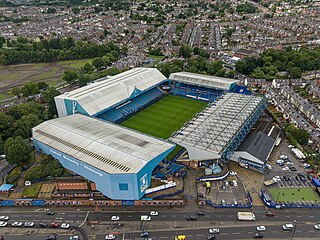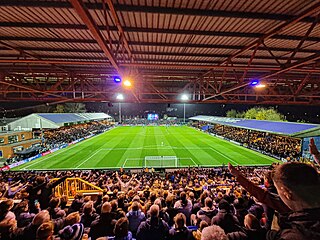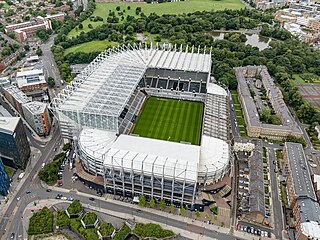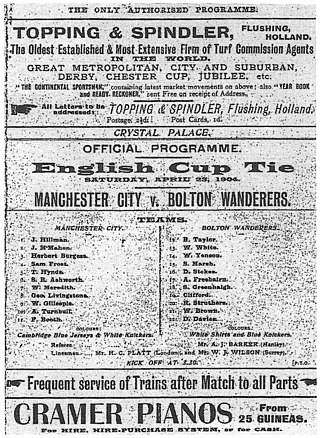
Hillsborough Stadium is a football stadium in the area of Owlerton, Sheffield, South Yorkshire, England. With a total capacity of 39,732, it has been the home of Sheffield Wednesday Football Club since opening in 1899.

Molineux Stadium is a football stadium situated in Wolverhampton, West Midlands, England. It has been the home ground of Premier League club Wolverhampton Wanderers since 1889. The first stadium built for use by a Football League club, it was one of the first British grounds to have floodlights installed and hosted some of the earliest European club games in the 1950s.

Lansdowne Road Stadium was a stadium in Dublin owned by the Irish Rugby Football Union (IRFU) that was primarily used for rugby union and association football matches. The stadium was demolished in 2007 to make way for the Aviva Stadium on the same site, which opened in 2010.

Edgeley Park is a football stadium in Edgeley, Stockport, England. Built for Stockport RFC, a rugby league club, in 1891, by 1903 the rugby club was defunct and Stockport County Football Club moved in. Sale Sharks Rugby Union Club also played at the ground between 2003 and 2012.

The City of Manchester Stadium, currently known as Etihad Stadium for sponsorship reasons, is the home of Premier League club Manchester City, with a domestic football capacity of 53,600, making it the 7th-largest football stadium in England and 11th-largest in the United Kingdom.

Maine Road was a football stadium in Moss Side, Manchester, England, that was home to Manchester City from 1923 to 2003. It hosted FA Cup semi-finals, the Charity Shield, a League Cup final and England matches. Maine Road's highest attendance of 84,569 was set in 1934 at an FA Cup sixth round match between Manchester City and Stoke City, a record for an English club ground.

St James' Park is a football stadium in Newcastle upon Tyne, England. It is the home of Newcastle United. With a seating capacity of 52,350 seats, it is the 8th largest football stadium in England.

Old Trafford is a football stadium in Old Trafford, Greater Manchester, England, and is the home of Manchester United. With a capacity of 74,310, it is the largest club football stadium in the United Kingdom, and the twelfth-largest in Europe. It is about 0.5 miles (800 m) from Old Trafford Cricket Ground and the adjacent tram stop.

Elland Road, also called Elland Road Football Stadium or Elland Road Stadium, is a football stadium in Beeston, Leeds, West Yorkshire, England, which has been the home of Championship club Leeds United since the club's formation in 1919. The stadium is the 13th largest football stadium in England.

Rugby Park, also known as The BBSP Stadium Rugby Park for sponsorship reasons, is a football stadium which is the home of Scottish Premiership club Kilmarnock F.C. and is situated in the Scottish town of Kilmarnock. With a capacity of 15,003, it is the 7th–largest football stadium in Scotland, and was first used in 1899, also having been used for concerts, rugby union and international football fixtures. The stadium underwent a major redevelopment in 1994–1995, becoming an all-seater stadium with a capacity of 18,128. In 2002, the club constructed the Park Hotel, a 4-star hotel complex next to the ground.

Gorton is an area of Manchester in Greater Manchester, England. It is to the southeast of Manchester city centre. The population at the 2011 census was 36,055. Neighbouring areas include Levenshulme and Openshaw.

Ardwick is an area of Manchester, in the county of Greater Manchester, England, one mile south-east of the city centre. The population at the 2011 census was 19,250.

The Manchester derby refers to football matches between Manchester City and Manchester United, first contested in 1881. City play at the City of Manchester Stadium in Bradford, east Manchester, while United play at Old Trafford in the borough of Trafford, Greater Manchester; the two grounds are separated by approximately 4 miles (6.4 km). The teams have played 194 matches in all competitions; United winning 79, City 61 and the remaining 54 have been drawn. Amongst the most successful clubs in England, they have won a combined 104 honours: 68 for Manchester United and 36 for Manchester City. They are also the first two English clubs and first cross-city rivals to have won the treble; United's success came in 1999, while City's occurred 24 years later.

North Road was a football and cricket ground in Newton Heath, Manchester, England. It was the first home of Manchester United Football Club – then known as Newton Heath Lancashire & Yorkshire Railway Football Club – from its foundation in 1878 until 1893, when the club moved to a new ground at Bank Street, Clayton.

Stair Park is a public park and football stadium in the town of Stranraer, Scotland and is the home of Stranraer F.C. It is owned by Dumfries and Galloway Council and is situated next to the London Road and the railway line in the town. The park features a bandstand, all weather tennis & netball courts, skatepark, football pitch and a football stadium. The park and stadium were named after the Earl of Stair, who bequeathed the land to the local authorities.

Belle Vue is a multi-purpose stadium in Rhyl, Wales. It is used mostly for football matches, and is the home ground of C.P.D. Y Rhyl 1879. The stadium holds 3,000 people, with a seating capacity of 1,720.

The 1904 FA Cup final was a football match between Bolton Wanderers and Manchester City on 23 April 1904 at Crystal Palace in London. The showpiece match of English football's primary cup competition, the Football Association Challenge Cup, it was the 33rd Cup final, and the tenth at Crystal Palace.
This page chronicles the history of Manchester City in further detail from its early years in 1880 to 1928. See Manchester City F.C. for an overview of the football club.

Hyde Road Stadium, in Manchester, England, often referred to as Belle Vue was the home of the Belle Vue Aces speedway team. The stadium's capacity was 40,000 and it was built in 1928 and used until demolished in 1987. It was claimed, incorrectly, to have been the first purpose-built speedway track in Britain.
Before Manchester City Football Club moved into their first permanent home in Manchester, England, in 1887, the club played at a short series of grounds which ranged from established cricket venues to bumpy fields with no stands or boundaries nor history of sporting usage. The club was founded as a philanthropic endeavour to encourage impressionable youths to commit to wholesome activities rather than falling to the local adolescent culture of alcohol and violence. The sport of football was barely 15 years from the writing of its own rulebook. The club had no immediate option of using or constructing a stadium, and thus most of their first locations were nothing more than painted lines and goalposts. As the club reformed and changed its name twice between 1880 and 1887, so its choice of locations were a series of low-cost, short-term solutions when their current location became untenable. In 1887, when City moved to their sixth pitch in only eight years, they had the money, ambition, reputation and stability to construct themselves a more permanent base of operations, at the stadium named Hyde Road.





















